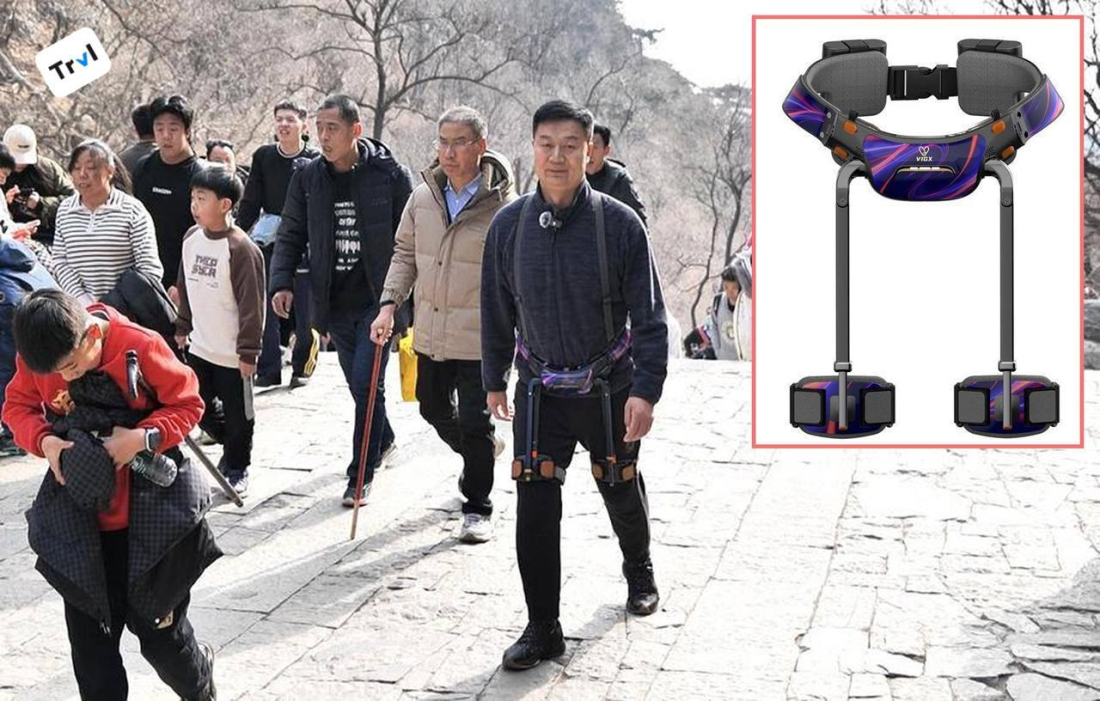Iran sees surge in protests as unrest spreads nationwide
Protests continued into another day in Iran, with crowds returning to the streets despite mounting pressure from the authorities. By scale and spread,...
Hong Kong (CNN) – A new trial of AI-powered robotic exoskeletons is making the arduous ascent of Mount Tai more accessible for Chinese tourists.
On January 29 - the first day of Chinese New Year - tourism officials in Shandong introduced the lightweight devices as part of a week-long trial. Over 200 visitors have tested the exoskeletons for a fee of 60 to 80 yuan per use.
Developed by Taishan Cultural Tourism Group in partnership with Shenzhen-based Kenqing Technology, the exoskeletons are designed to wrap around the wearers’ waists and thighs, weighing just 1.8 kilograms. Powered by AI algorithms that sense and synchronize with users’ movements, the device provides assistance to ease the strain on tired legs during the climb up Mount Tai—a 5,000-foot-high peak featuring more than 7,000 steps.
Each unit runs on two batteries, delivering about five hours of support—nearly matching the typical six-hour climb to the summit. “It really works! It felt like someone was pulling me uphill!” said Li Chengde, a 68-year-old tourist from Jinan who participated in the trial.

Local officials believe the technology could broaden access to the mountain for a variety of visitors, including the elderly, children, and those with limited mobility. “This can help more people hike up the mountain and enjoy the scenery of Mount Tai without it being too strenuous,” said Wang Houzhe, Deputy Secretary of the Party Committee of the Taishan Cultural Tourism Group.
However, not all feedback has been entirely positive. A content creator, known only by the pseudonym Jacky, noted that while the device made the climb easier, it also created challenges. “The experience is definitely easier with the exoskeleton, but once I took it off, I felt clumsy walking on my own,” he said. Jacky also mentioned difficulties with routine tasks, such as tying shoelaces and using the restroom, and highlighted that the battery life could be improved. In response, officials indicated plans to extend battery performance and set up battery replacement stations along the trails.
Currently in beta testing, the exoskeletons are expected to be available to the mass market in early March, according to local authorities. The trial has also sparked broader discussions about the potential applications of robotic assistance in elderly care. With over 22% of China’s population aged 60 or above last year—a figure projected to reach 30% by 2035—the market for smart elderly care, estimated at 6.8 trillion yuan in 2024, is growing rapidly.
Kenqing Technology, which was founded in 2015, is also developing a version of the exoskeleton tailored for elderly users. This model, weighing 2.4 kilograms and priced at 17,000 yuan on Taobao, underscores the company’s ambition to tap into the expansive elderly care market.
As the trial continues at Mount Tai, both officials and developers remain optimistic that robotic exoskeletons could play a significant role in enhancing accessibility and enriching the tourism experience at one of China’s most iconic landmarks.
Germany’s foreign intelligence service secretly monitored the telephone communications of former U.S. President Barack Obama for several years, including calls made aboard Air Force One, according to an investigation by the German newspaper Die Zeit.
Israeli media report that Israeli Prime Minister Benjamin Netanyahu chaired a lengthy security meeting that reportedly focused on the country’s regional threats, including Gaza, Lebanon, and Iran.
At the end of last year, U.S. President Donald Trump was reported to have raised the Azerbaijan–Armenia peace agenda during a conversation with Israel’s prime minister, warning that if peace were not achieved, Washington could raise tariffs on both countries by 100 percent.
President Ilham Aliyev said 2025 has politically closed the Armenia-Azerbaijan conflict, as a Trump-era reset in U.S. ties, new transport corridors and a push into AI, renewables and defence production reshape Azerbaijan’s priorities.
Dmitry Medvedev has warned that Ukrainian President Volodymyr Zelenskyy could face the same fate as Venezuelan leader Nicolás Maduro, following what he described as a U.S. ‘abduction’ of the Venezuelan president.
Tesla delivered 1.64 million vehicles in 2025, down 9%, as BYD becomes the top EV maker.
SpaceX will gradually lower 4,400 Starlink satellites this year to improve space safety.
Poland has asked the European Commission to investigate TikTok after artificial intelligence-generated content calling for the country to leave the European Union appeared on the platform, which Warsaw says was likely Russian disinformation.
Tianhui-7 satellite to be used for geographic mapping, land resource surveys, and scientific research.
Iran successfully launched three satellites on Sunday using a Russian Soyuz rocket from Russia’s Far East, marking the latest stage in growing Iran-Russia space cooperation.
You can download the AnewZ application from Play Store and the App Store.

What is your opinion on this topic?
Leave the first comment